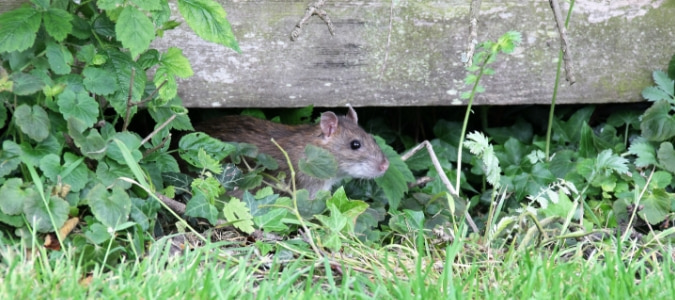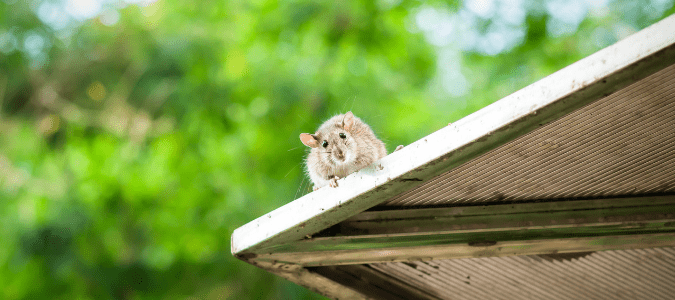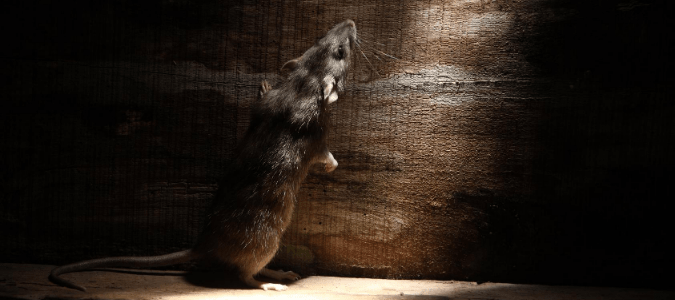
Have you noticed signs of rats living somewhere in your home, attic or garage? If you suspect you have a rat infestation, it’s unsettling—and trying to address it on your own can quickly lead to frustration, as you learn that setting out a few traps won’t be enough to resolve the problem. Like mice and other wild rodent pests, rats are opportunists. They are also wily, clever animals. They enter people’s homes (and other buildings on the property) in search of food and shelter. If they find an opening, they’ll use it to get inside. Rats are also prolific breeders, so if they have a chance to build a nest, their population can expand quickly.
You may notice signs of rats in your home, but you’re even more likely to find them in your attic, garage, shed or some other less-visited place on your property. Since rats are nocturnal, they’re most active at night. So, you may spot new signs of rat activity during the daytime but never see an actual rat.
Here are some of the most common signs of rats that people tend to notice in and around their homes:
- Droppings scattered in corners, on floors or on top or inside of cabinets. Rat droppings are dark brown or black, elongated pellets that are a half-inch or so in length. They may be rounded or more pointed at the ends, depending on the type of rat.
- Gnaw marks on drywall, wooden beams, baseboards, PVC pipes and the trim around doors or windows. Rats have continuously growing front teeth that require frequent chewing to keep them filed down. This can result in a surprising amount of damage to your home or garage.
- Nesting materials such as shredded paper or cloth, ripped up insulation, or dead leaves and other plant matter. These may indicate the presence of a rat nest nearby.
- Dark, greasy track marks along baseboards, walls or ceiling perimeters, or leading in and out of access points. Rats are creatures of habit, following the same paths between their nests and their primary food and water sources. They also prefer to walk along walls rather than out in the open. The natural oils in their fur rub off on walls and baseboards as they travel their daily paths, which can result in visible track marks.
- Squeaking or scratching sounds coming from behind a wall or in the ceiling, especially at night. These are some of the typical sounds that rats make when they have built a nest in the inner framework of your home or garage.
- Pets staring at the wall or ceiling. Both dogs and cats have been known to stare fixedly at seemingly random points on the wall or ceiling, or to whine or scratch at the wall or baseboards. They may be doing this because they can hear or smell rodents nearby.
- An actual rat sighting, whether alive or dead. Unfortunately, if you see even just one rat, it can be a sign that there are others hidden nearby.
If you notice signs of rats living on your property, it’s important to get rid of them as quickly as possible. Rats are known carriers of diseases like hantavirus, leptospirosis and rat bite fever. They can transfer these illnesses through their bites, feces or urine to both people and their pets. Rats are also known to cause extensive property damage to people’s homes if they are allowed to build nests and reproduce—and these rodents reproduce incredibly quickly. One female rat can give birth to nearly fifty baby rats in a year. With that in mind, it’s easy to see how a rat infestation can quickly grow out of control.
Fortunately, there are several steps you can take in tandem with professional pest control measures to control rat populations and keep these unwanted animals away from your home and property. Remember, rats, like all animals, are primarily seeking food, water and shelter. Keeping that in mind, here are some things you can do to deter these pests from invading your home, attic or garage:
- Store all food in your home and garage, including pet and bird food, in airtight containers.
- Put pet food and water bowls away at night.
- Fix any leaky pipes or faucets to eliminate easy water sources for pests.
- Repair or close off any holes, gaps or other potential access points that might give rats a way into your home. Look for holes or gaps around eaves, vents, hose bibs, windows and exterior doors. Gaps can be repaired using wood, steel wool or wire mesh.
- Maintain your yard and keep it clear of dead leaves, fallen limbs, overgrown shrubs and dead trees—anything rats might use for nesting outdoors.
- Keep your garbage and recycling bins in the garage if possible, and make sure their lids fit tightly to discourage rats, raccoons and other pests from breaking into them.
If you think you have rats living and breeding somewhere in or near your home, it’s important to deal with the problem as quickly and thoroughly as possible so it doesn’t grow exponentially out of control. And to dispel a common myth: it is not enough to rely on a cat, dog or another animal that eats rats to do the rodent control for you.
While you wait for a pest control specialist to arrive at your home, there are some ways you can educate yourself on rodents and what the rodent control process entails. Keep reading to learn how rats get in the attic and signs that there are rats living underneath your home.

How Do Rats Get in the Attic?
If you see any signs of rats in the attic of your home, you may feel distressed—and confused. How do rats get in the attic in the first place? Are they good climbers, or is there some other way they get in?
In fact, rats are excellent climbers. They can even climb almost any vertical surface except glass. Furthermore, several types of rats live in trees. In many cases, rats that get into people’s attics have climbed there from trees overhanging the roof and eaves. This is why it’s important to keep tree branches trimmed away from your roof line. Regular tree trimming protects your home not only from falling limbs, but also keeps creatures like rats, squirrels and raccoons off your roof.
If rats have gotten into your attic, a pest control professional will be able to determine the most likely way they got in and find these access points, so those can be closed off. Often, the holes rats use to get into the attic are surprisingly small. If your home’s roof line is high up, you may not have a safe way to climb up and inspect the eaves to look for gaps and holes yourself. This is another reason it’s often best to contact a professional exterminator, who has the proper tools for getting the job done safely and correctly, can get rid of all of the rodents.

Signs of Rats Under the House
If your home is newer, it may be built on a concrete slab foundation, but if it’s older, it may have pier-and-beam construction. In pier-and-beam homes, there is an open space underneath the house that rats and other wildlife can potentially access. Rats, like other animals, seek warmth and shelter during the colder months of the year, and this space under your home can provide them the safety they need to survive. It can be tough to spot signs of rats under the house, however, since most people don’t usually venture into the dark, cramped crawl spaces beneath their homes. This means you could have an extensive rat problem on your hands before you ever notice any signs or realize what’s going on.
If you do shine a flashlight into the area under your house and spot any of the classic signs of rats, it’s time to contact a pest management professional to determine whether you have a pest infestation and how to deal with it. Typical signs of rats living under a home include rat droppings, gnaw marks, squeaking or scratching noises coming from under the floor and the presence of nesting materials such as shredded fabric, insulation or leaves.
The main way to keep rats and other pests from nesting underneath your house is to close off their access to these spaces. In some cases, this means building a barrier that completely encloses area underneath a home. In other cases, this means repairing holes and closing off gaps that allow rats to get inside. Remember, these animals can squeeze through any hole that is larger than a nickel. If there is any type of door or trap door that leads the space under the house, be sure to keep it closed so animals can’t get through.
Also, be sure to contact a reputable pest control specialist who can help you determine the nature and scope of the infestation. These professionals can figure out the best approach to getting rid of pests and keeping them away in the future.
ABC Can Remove Rodents and Prevent Their Return
Managing a pest problem can be unnerving for a number of reasons. If rodents, wildlife or any other variety of animal or insect pest is giving you trouble, contact ABC. Our highly-trained specialists can remove any unwelcome visitors on your property, so you can feel comfortable at home again. For further peace of mind, we provideyou with ongoing pest management to help you avoid future problems.
